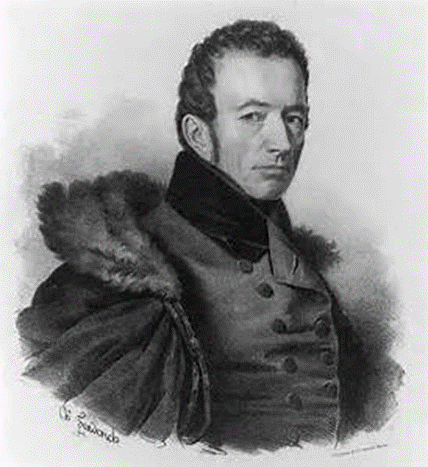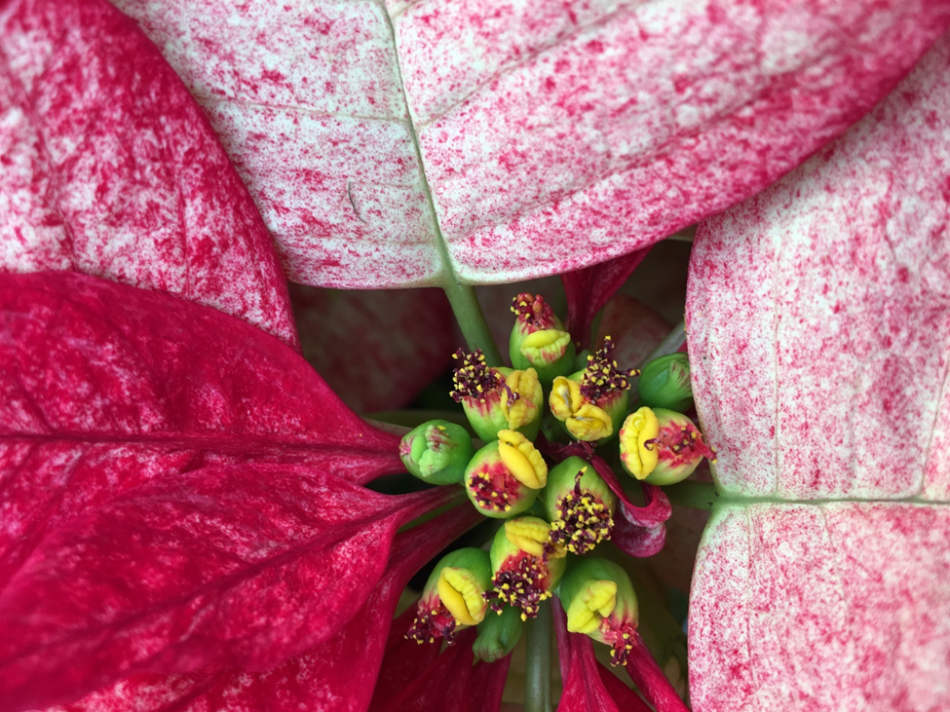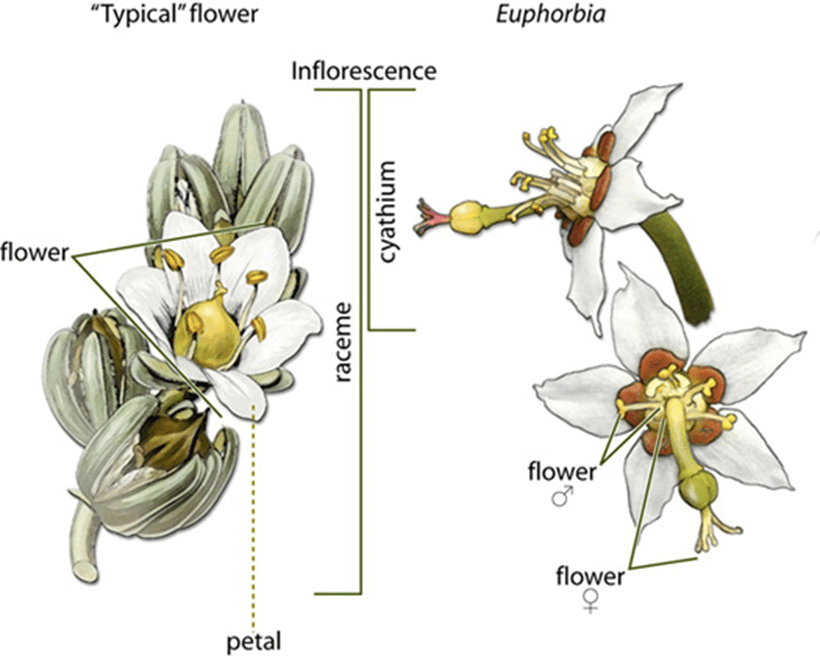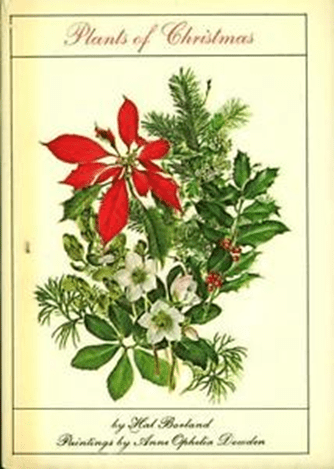Mwalimu-G
Elder Lister
CHRISTMAS
A Winter’s Tale

BY PATRICK RYAN
DECEMBER 23, 2022
COMMENTS 0
I’d venture a guess that you have at least one poinsettia in your house this holiday season. If not, maybe learning a little about this interesting shrub from Mexico, and how it became THE plant of Christmas, will tempt you to bring one (or more!) home.
The Legend
As the story goes, a poor young peasant girl in Mexico was embarrassed that she didn’t have a gift to bring to the church at Christmas. A stranger (an angel?) told her to pick the weeds along the roadside and take them to the church, saying any gift from the heart would be appreciated.
As she placed them near the manger, the weeds were transformed into beautiful red flowers. This miracle caused the plant to become known as the Flor de Nocha Buena, the flower of the Holy Night.
 You can read a nice version of this story by Tomie de Paola.
You can read a nice version of this story by Tomie de Paola.
So what’s the story on the actual plant? Poinsettia (Euphorbia pulcherrima) is the best-known member of the spurge family, Euphorbiaceae. In the wild, poinsettias can grow into a tall and rangy tree, up to eight feet tall, with blazing red leaves.
The epithet pulcherrima, by the way, comes from the Latin word for beautiful.
History of the Poinsettia
Poinsettias were introduced to the United States in 1825 by Joel Roberts Poinsett. Mr. Poinsett was a botanist, and the first United States Ambassador to Mexico. December 12 is National Poinsettia Day, marking the death of Poinsett in 1851.

Formerly, most of the poinsettias grown in the U.S., and about half in Europe, were grown by the Ecke Ranch.
According to an article by David Wagner in the San Francisco Chronicle, the Ecke family turned the poinsettia into the best-selling potted plant in America and his business into a bona fide monopoly. At the peak of their success, these poinsettia moguls commanded upward of 90 percent of the American market.
Although the traditional red and green poinsettia still reigns supreme, Ecke Ranch continued to cultivate “offbeat novelty types that the younger generation could identify with,” as Ecke III said. One of his favorites is ‘Ice Punch,’ a red and white “tie-dyed” variety.
Poinsettias Today
Headquartered in the Netherlands, Dümmen Orange is today a leading international breeder and propagator focused on potted plants, bedding plants, perennials, tropical plants, cut flowers, and bulbs. Their poinsettia program is a combination of two trusted brands: Ecke and Red Fox. Poinsettia cuttings come from the mother plant location in Ethiopia.
According to their website, “recent breeding has produced a poinsettia with a much longer post-harvest life and more desirable cut flower characteristics such as longer, sturdier stems and larger flower heads. Easily grown as cut flowers, poinsettias are perfect for Christmas and other holidays such as Valentine’s Day. Cut poinsettias are a festive addition to a holiday table or celebration. The unique colors and flower form are ideal for high-end bouquets.”
In Anchorage, Bell’s Nursery is the premiere nursery for poinsettias. According to their website, the story starts in July as they begin to nurture the baby poinsettia cuttings by reducing their exposure to sunlight, by keeping the temperature at an even 70°F, and by regular watering. Every year they grow deep reds, blushing pinks, two-toned salmons, pristine whites, deep burgundies, and always new varieties.
Leaves or Flowers?
You probably know that that the red leaf-like structures are not the flowers. They are actually bracts, which, according to the Encyclopedia Britannica, are usually small, leaf-like structure often positioned beneath a flower. Well, then, where’s the flower?
The small round cyathium in the center is the flower.
Knowing this will help you pick the freshest plant. See the picture below showing the green or yellow orbs that will soon bloom and drop pollen on the bracts. Plants at the stage shown below will last longer than those with yellow grains of pollen on them.
 Photo: Patrick Ryan
Photo: Patrick Ryan
Here’s another view of the cyathium, which is unique to the plants in the genus Euphorbia, of which the poinsettia is one.
 Photo: euphorbiaceae.org.More About Poinsettias
Photo: euphorbiaceae.org.More About Poinsettias
To learn more about this and other seasonal plants, I recommend a classic, from 1987, Plants of Christmas by Hal Borland (Author), Anne Ophelia Dowden (Painter).

Another good site to learn more and deepen your appreciation of this lovely plant can be found at:
A Winter’s Tale

BY PATRICK RYAN
DECEMBER 23, 2022
COMMENTS 0
I’d venture a guess that you have at least one poinsettia in your house this holiday season. If not, maybe learning a little about this interesting shrub from Mexico, and how it became THE plant of Christmas, will tempt you to bring one (or more!) home.
The Legend
As the story goes, a poor young peasant girl in Mexico was embarrassed that she didn’t have a gift to bring to the church at Christmas. A stranger (an angel?) told her to pick the weeds along the roadside and take them to the church, saying any gift from the heart would be appreciated.
As she placed them near the manger, the weeds were transformed into beautiful red flowers. This miracle caused the plant to become known as the Flor de Nocha Buena, the flower of the Holy Night.
 You can read a nice version of this story by Tomie de Paola.
You can read a nice version of this story by Tomie de Paola.So what’s the story on the actual plant? Poinsettia (Euphorbia pulcherrima) is the best-known member of the spurge family, Euphorbiaceae. In the wild, poinsettias can grow into a tall and rangy tree, up to eight feet tall, with blazing red leaves.
The epithet pulcherrima, by the way, comes from the Latin word for beautiful.
History of the Poinsettia
Poinsettias were introduced to the United States in 1825 by Joel Roberts Poinsett. Mr. Poinsett was a botanist, and the first United States Ambassador to Mexico. December 12 is National Poinsettia Day, marking the death of Poinsett in 1851.

Formerly, most of the poinsettias grown in the U.S., and about half in Europe, were grown by the Ecke Ranch.
According to an article by David Wagner in the San Francisco Chronicle, the Ecke family turned the poinsettia into the best-selling potted plant in America and his business into a bona fide monopoly. At the peak of their success, these poinsettia moguls commanded upward of 90 percent of the American market.
Although the traditional red and green poinsettia still reigns supreme, Ecke Ranch continued to cultivate “offbeat novelty types that the younger generation could identify with,” as Ecke III said. One of his favorites is ‘Ice Punch,’ a red and white “tie-dyed” variety.
Poinsettias Today
Headquartered in the Netherlands, Dümmen Orange is today a leading international breeder and propagator focused on potted plants, bedding plants, perennials, tropical plants, cut flowers, and bulbs. Their poinsettia program is a combination of two trusted brands: Ecke and Red Fox. Poinsettia cuttings come from the mother plant location in Ethiopia.
According to their website, “recent breeding has produced a poinsettia with a much longer post-harvest life and more desirable cut flower characteristics such as longer, sturdier stems and larger flower heads. Easily grown as cut flowers, poinsettias are perfect for Christmas and other holidays such as Valentine’s Day. Cut poinsettias are a festive addition to a holiday table or celebration. The unique colors and flower form are ideal for high-end bouquets.”
In Anchorage, Bell’s Nursery is the premiere nursery for poinsettias. According to their website, the story starts in July as they begin to nurture the baby poinsettia cuttings by reducing their exposure to sunlight, by keeping the temperature at an even 70°F, and by regular watering. Every year they grow deep reds, blushing pinks, two-toned salmons, pristine whites, deep burgundies, and always new varieties.
Leaves or Flowers?
You probably know that that the red leaf-like structures are not the flowers. They are actually bracts, which, according to the Encyclopedia Britannica, are usually small, leaf-like structure often positioned beneath a flower. Well, then, where’s the flower?
The small round cyathium in the center is the flower.
Knowing this will help you pick the freshest plant. See the picture below showing the green or yellow orbs that will soon bloom and drop pollen on the bracts. Plants at the stage shown below will last longer than those with yellow grains of pollen on them.
 Photo: Patrick Ryan
Photo: Patrick RyanHere’s another view of the cyathium, which is unique to the plants in the genus Euphorbia, of which the poinsettia is one.
 Photo: euphorbiaceae.org.More About Poinsettias
Photo: euphorbiaceae.org.More About PoinsettiasTo learn more about this and other seasonal plants, I recommend a classic, from 1987, Plants of Christmas by Hal Borland (Author), Anne Ophelia Dowden (Painter).

Another good site to learn more and deepen your appreciation of this lovely plant can be found at:
